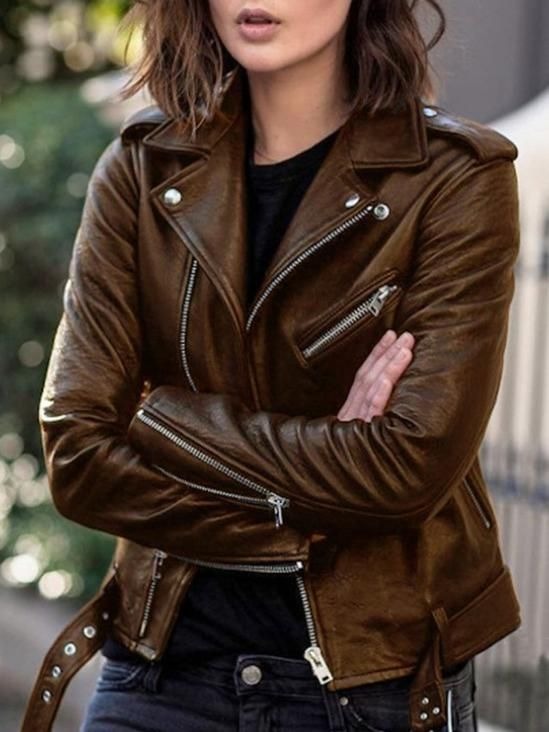A leather jacket is a timeless piece of clothing that can add a touch of elegance, edginess, or casual cool to any outfit. However, finding the perfect women leather jacket can be a daunting task. With so many options available, it’s essential to know what to look for to ensure you make the best choice. This guide will help you navigate the process with ease and confidence.
1. Style and Design
When it comes to style, a leather jacket should reflect your personality and wardrobe needs. Are you drawn to the classic biker jacket with its asymmetrical zippers and rebellious flair? Or do you prefer a sleek, minimalist design that can transition seamlessly from day to night? Perhaps a bomber jacket or a trench coat style appeals to you more. The key is to choose a design that not only looks good but also complements your lifestyle.
2. Fit and Size
A well-fitted leather jacket can make all the difference. It should hug your body snugly without being too tight or too loose. To find the right size, consider the following tips:
- Shoulders: The seams should align with your shoulder bones.
- Sleeves: They should reach your wrists without going over your hands.
- Length: The jacket should hit at your waist or hips, depending on the style.
Trying on different sizes and moving around in them will help you determine the best fit.
3. Leather Quality
Not all leather is created equal. The type of leather used can significantly impact the jacket’s durability, comfort, and appearance. Here are some common types:
- Full-Grain Leather: The highest quality, known for its durability and natural look.
- Top-Grain Leather: Slightly processed but still high-quality, offering a smoother finish.
- Genuine Leather: Lower quality, often made from leftover layers after top layers are split.
- Faux Leather: Synthetic material, an affordable and animal-friendly option.
Investing in a high-quality leather jacket ensures longevity and a better return on investment.
4. Lining Material
The lining inside the jacket is just as important as the exterior. A good lining provides comfort, insulation, and breathability. Common lining materials include:
- Polyester: Durable and smooth.
- Cotton: Breathable and comfortable.
- Silk: Luxurious and soft, but less durable.
- Fleece or Shearling: Provides warmth, ideal for colder climates.
Choosing the right lining depends on the climate and your comfort preferences.
5. Stitching and Craftsmanship
Attention to detail is crucial in a leather jacket. Examine the stitching to ensure it is even and robust, as this indicates quality craftsmanship. Double stitching in high-stress areas like the shoulders and elbows adds durability. High-quality zippers, buttons, and other hardware should function smoothly and be securely attached.
6. Color Options
While black and brown are classic choices for leather jackets, don’t be afraid to explore other colors. A bold red or deep burgundy can make a statement, while a neutral beige or gray offers versatility. Consider your wardrobe and choose a color that complements your existing pieces and personal style.
7. Hardware and Details
The hardware on a leather jacket, including zippers, buttons, and buckles, can enhance its overall look and functionality. Opt for high-quality metal hardware that matches the jacket’s style. Details like pockets, belts, and decorative stitching add to the jacket’s character and should be chosen based on both aesthetic and practical considerations.
8. Brand and Price
Brand reputation often correlates with quality, but it’s not the only factor to consider. Do some research on brands known for their leather goods and read customer reviews. Price is also a significant consideration. While it’s tempting to go for cheaper options, investing in a well-made jacket from a reputable brand will pay off in the long run.
9. Purpose and Occasion
Think about where and when you’ll be wearing your leather jacket. A lightweight, unlined jacket might be perfect for spring and fall, while a heavier, lined version is better suited for winter. For formal occasions, a sleek, minimalist design works best, whereas a rugged, detailed jacket is great for casual outings.
10. Care and Maintenance
Proper care can extend the life of your leather jacket. Here are some tips:
- Cleaning: Use a damp cloth for minor spots and a leather cleaner for tougher stains.
- Conditioning: Apply a leather conditioner periodically to keep the leather supple.
- Storage: Store your jacket on a padded hanger in a cool, dry place, away from direct sunlight.
- Waterproofing: Consider using a leather protectant spray to guard against water damage.
By following these maintenance tips, you can keep your jacket looking great for years to come.
Conclusion
Buying a women leather jacket is an investment in both style and functionality. By considering factors such as style, fit, leather quality, lining, craftsmanship, color, hardware, brand, purpose, and maintenance, you can find a jacket that not only enhances your wardrobe but also stands the test of time. Happy shopping!
FAQs
1. How can I tell if a leather jacket is of good quality?
Look for full-grain or top-grain leather, even stitching, and high-quality hardware. The jacket should feel substantial and well-made.
2. What is the best way to care for my leather jacket?
Clean it with a damp cloth, condition it regularly, store it properly, and use a leather protectant spray to maintain its condition.
3. Can I wear a leather jacket in the rain?
While brief exposure to rain won’t ruin a leather jacket, it’s best to avoid prolonged wetness. Use a leather protectant spray to enhance water resistance.
4. How do I choose the right size for a leather jacket?
Ensure the shoulder seams align with your shoulders, the sleeves reach your wrists, and the jacket fits snugly but comfortably around your body.
5. Are there eco-friendly leather jacket options?
Yes, look for jackets made from vegetable-tanned leather or faux leather options that do not use harmful chemicals in their production.

